Zeolite
Zeolites are microporous, aluminosilicate minerals commonly used as commercial adsorbents and catalysts.[1] The term zeolite was originally coined in 1756 by Swedish mineralogist Axel Fredrik Cronstedt, who observed that rapidly heating the material, believed to have been stilbite, produced large amounts of steam from water that had been adsorbed by the material. Based on this, he called the material zeolite, from the Greek ζέω (zéō), meaning "to boil" and λίθος (líthos), meaning "stone".[2] The classic reference for the field has been Breck's book Zeolite Molecular Sieves: Structure, Chemistry, And Use.[3]
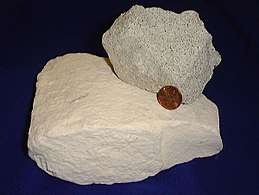
Zeolites occur naturally but are also produced industrially on a large scale. As of December 2018, 245 unique zeolite frameworks have been identified, and over 40 naturally occurring zeolite frameworks are known.[4][5] Every new zeolite structure that is obtained is examined by the International Zeolite Association Structure Commission and receives a three letter designation.[6]
Properties and occurrence
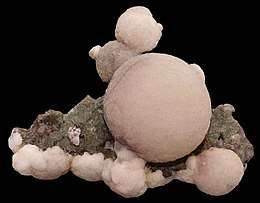
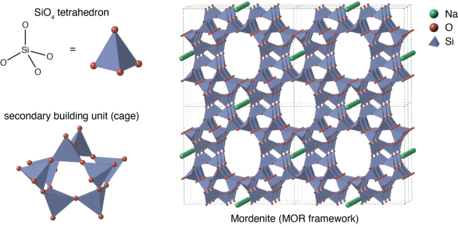
Zeolites have a porous structure that can accommodate a wide variety of cations, such as Na+, K+, Ca2+, Mg2+ and others. These positive ions are rather loosely held and can readily be exchanged for others in a contact solution. Some of the more common mineral zeolites are analcime, chabazite, clinoptilolite, heulandite, natrolite, phillipsite, and stilbite. An example of the mineral formula of a zeolite is: Na
2Al
2Si
3O
10·2H2O, the formula for natrolite. These cation exchanged zeolites possess different acidity and catalyse several acid catalysis.[7][8][9]
Natural zeolites form where volcanic rocks and ash layers react with alkaline groundwater. Zeolites also crystallize in post-depositional environments over periods ranging from thousands to millions of years in shallow marine basins. Naturally occurring zeolites are rarely pure and are contaminated to varying degrees by other minerals, metals, quartz, or other zeolites. For this reason, naturally occurring zeolites are excluded from many important commercial applications where uniformity and purity are essential.
Zeolites are the aluminosilicate ( and ) members of the family of microporous solids known as "molecular sieves", and mainly consist of Si, Al, O, and metals including Ti, Sn, Zn, and so on. The term molecular sieve refers to a particular property of these materials, i.e., the ability to selectively sort molecules based primarily on a size exclusion process. This is due to a very regular pore structure of molecular dimensions. The maximum size of the molecular or ionic species that can enter the pores of a zeolite is controlled by the dimensions of the channels. These are conventionally defined by the ring size of the aperture, where, for example, the term "8-ring" refers to a closed loop that is built from eight tetrahedrally coordinated silicon (or aluminium) atoms and 8 oxygen atoms. These rings are not always perfectly symmetrical due to a variety of causes, including strain induced by the bonding between units that are needed to produce the overall structure, or coordination of some of the oxygen atoms of the rings to cations within the structure. Therefore, the pores in many zeolites are not cylindrical.
Zeolites transform to other minerals under weathering, hydrothermal alteration or metamorphic conditions. Some examples:[10]
- The sequence of silica-rich volcanic rocks commonly progresses from:
- Clay → quartz → mordenite–heulandite → epistilbite → stilbite → thomsonite–mesolite-scolecite → chabazite → calcite.
- The sequence of silica-poor volcanic rocks commonly progresses from:
Production
Industrially important zeolites are produced synthetically. Typical procedures entail heating aqueous solutions of alumina and silica with sodium hydroxide. Equivalent reagents include sodium aluminate and sodium silicate. Further variations include changes in the cations to include quaternary ammonium cations.[11]
Synthetic zeolites hold some key advantages over their natural analogues. The synthetic materials are manufactured in a uniform, phase-pure state. It is also possible to produce zeolite structures that do not appear in nature. Zeolite A is a well-known example. Since the principal raw materials used to manufacture zeolites are silica and alumina, which are among the most abundant mineral components on earth, the potential to supply zeolites is virtually unlimited.
Natural occurrence
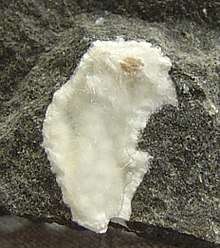
Conventional open-pit mining techniques are used to mine natural zeolites. The overburden is removed to allow access to the ore. The ore may be blasted or stripped for processing by using tractors equipped with ripper blades and front-end loaders. In processing, the ore is crushed, dried, and milled. The milled ore may be air-classified as to particle size and shipped in bags or bulk. The crushed product may be screened to remove fine material when a granular product is required, and some pelletized products are produced from fine material.
As of 2016 the world's annual production of natural zeolite approximates 3 million tonnes. Major producers in 2010 included China (2 million tonnes), South Korea (210,000 t), Japan (150,000 t), Jordan (140,000 t), Turkey (100,000 t) Slovakia (85,000 t) and the United States (59,000 t).[12] The ready availability of zeolite-rich rock at low cost and the shortage of competing minerals and rocks are probably the most important factors for its large-scale use. According to the United States Geological Survey, it is likely that a significant percentage of the material sold as zeolites in some countries is ground or sawn volcanic tuff that contains only a small amount of zeolites. Some examples of such usage include dimension stone (as an altered volcanic tuff), lightweight aggregate, pozzolanic cement, and soil conditioners.[13]
Artificial synthesis
There are over 200 synthetic zeolites that have been synthesized by a process of slow crystallization of a silica-alumina gel in the presence of alkalis and organic templates. Many more such structures could theoretically be made.[14] In addition to variations in structures, zeolites can also be made with a variety of other atoms in them to make them chemically interesting and active. Some examples of the so-called heteroatoms that have been incorporated include germanium, iron, gallium, boron, zinc, tin, and titanium.[15] One of the important processes used to carry out zeolite synthesis is sol-gel processing. The product properties depend on reaction mixture composition, pH of the system, operating temperature, pre-reaction 'seeding' time, reaction time as well as the templates used. In sol-gel process, other elements (metals, metal oxides) can be easily incorporated. The silicalite sol formed by the hydrothermal method is very stable. The ease of scaling up this process makes it a favorite route for zeolite synthesis.
The zeolite conundrum
Computer calculations have predicted that millions of hypothetical zeolite structures are possible. However, only 232 of these structures have been discovered and synthesized so far, so many zeolite scientists question why only this small fraction of possibilities are being observed. This problem is often referred to as "the bottleneck problem". Currently there are a number of theories attempting to explain the reasoning behind this question.
- Zeolite synthesis research has primarily been concentrating on hydrothermal methods; however, new zeolites may be synthesized using alternative methods. Synthesis methods that have started to gain use include: microwave-assisted, post-synthetic modification, steam.
- Geometric computer simulations have shown that the discovered zeolite frameworks possess a behaviour known as "the flexibility window". This shows that there is a range in which the zeolite structure is "flexible" and can be compressed but retain the framework structure. It is suggested that if a framework does not possess this property then it cannot be feasibly synthesised.
- As zeolites are metastable, certain frameworks may be inaccessible as nucleation cannot occur because more stable and energetically favourable zeolites will form. Post-synthetic modification has been used to combat this issue with the ADOR method,[16] whereby frameworks can be cut apart into layers and bonded back together by either removing silica bonds or including them.
Uses of zeolites
Zeolites are widely used as ion-exchange beds in domestic and commercial water purification, softening, and other applications. In chemistry, zeolites are used to separate molecules (only molecules of certain sizes and shapes can pass through), and as traps for molecules so they can be analyzed.
Zeolites are also widely used as catalysts and sorbents. Their well-defined pore structure and adjustable acidity make them highly active in a large variety of reactions.[17]
Zeolites have the potential of providing precise and specific separation of gases, including the removal of H2O, CO2 and SO2 from low-grade natural gas streams. Other separations include noble gases, N2, O2, freon and formaldehyde.
Zeolites assist silver in naturally emitting light, which could lead to new lighting technologies—supplementing or replacing fluorescent lights or LEDs.[18]
On-board oxygen generating systems (OBOGS) and oxygen concentrators use zeolites in conjunction with pressure swing adsorption to remove nitrogen from compressed air in order to supply oxygen for aircrews at high altitudes, as well as home and portable oxygen supplies.[19]
Industry
Synthetic zeolites, as other mesoporous materials (e.g. MCM-41), are widely used as catalysts in the petrochemical industry, for instance in fluid catalytic cracking and hydrocracking. Zeolites confine molecules in small spaces, which causes changes in their structure and reactivity. The acidic forms of zeolites prepared are often powerful solid-state solid acids, facilitating a host of acid-catalyzed reactions, such as isomerisation, alkylation, and cracking.
Catalytic cracking uses reactor and a regenerator. Feed is injected onto hot, fluidized catalyst where large gasoil molecules are broken into smaller gasoline molecules and olefins. The vapor-phase products are separated from the catalyst and distilled into various products. The catalyst is circulated to a regenerator where air is used to burn coke off the surface of the catalyst that was formed as a byproduct in the cracking process. The hot regenerated catalyst is then circulated back to the reactor to complete its cycle.
Zeolites have uses in advanced nuclear-waste reprocessing methods, where their micro-porous ability to capture some ions while allowing others to pass freely allows many fission products to be efficiently removed from the waste and permanently trapped. Equally important are the mineral properties of zeolites. Their alumino-silicate construction is extremely durable and resistant to radiation even in porous form. Additionally, once they are loaded with trapped fission products, the zeolite-waste combination can be hot pressed into an extremely durable ceramic form, closing the pores and trapping the waste in a solid stone block. This is a waste form factor that greatly reduces its hazard compared to conventional reprocessing systems. Zeolites are also used in the management of leaks of radioactive materials. For example, in the aftermath of the Fukushima Daiichi nuclear disaster, sandbags of zeolite were dropped into the seawater near the power plant to adsorb radioactive caesium which was present in high levels.[20]
The German group Fraunhofer e.V. announced that they had developed a zeolite substance for use in the biogas industry for long-term storage of energy at a density 4x more than water.[21] Ultimately, the goal is to be able to store heat both in industrial installations and in small combined heat and power plants such as those used in larger residential buildings.
Solar energy storage and use
Zeolites can be used to thermochemically store solar heat harvested from solar thermal collectors as first taught by Guerra in 1978[22] and for adsorption refrigeration as first taught by Tchernev in 1974[23]. In these applications, their high heat of adsorption and ability to hydrate and dehydrate while maintaining structural stability is exploited. This hygroscopic property coupled with an inherent exothermic (energy releasing) reaction when transitioning from a dehydrated to a hydrated form make natural zeolites useful in harvesting waste heat and solar heat energy.
Commercial and domestic
Zeolites are also used as a molecular sieve in cryosorption style vacuum pumps.[24]
The largest single use for zeolite is the global laundry detergent market. This amounted to 1.44 million metric tons per year of anhydrous zeolite A in 1992.
Non-clumping cat litter is often made of zeolite or diatomite.
Synthetic zeolites are used as an additive in the production process of warm mix asphalt concrete. The development of this application started in Germany in the 1990s. They help by decreasing the temperature level during manufacture and laying of asphalt concrete, resulting in lower consumption of fossil fuels, thus releasing less carbon dioxide, aerosols, and vapours. The use of synthetic zeolites in hot mixed asphalt leads to easier compaction and, to a certain degree, allows cold weather paving and longer hauls.
When added to Portland cement as a pozzolan they can reduce chloride permeability and improve workability. They reduce weight and help moderate water content while allowing for slower drying which improves break strength.[25] When added to lime mortars and lime-metakaolin mortars, synthetic zeolite pellets can act simultaneously as pozzolanic material and water reservoir.[26][27]
Debbie Meyer Green Bags, a produce storage and preservation product, uses a form of zeolite as its active ingredient. The bags are lined with zeolite to adsorb ethylene, which is intended to slow the ripening process and extend the shelf life of produce stored in the bags.
Gemstones
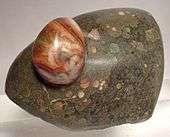
Thomsonites, one of the rarer zeolite minerals, have been collected as gemstones from a series of lava flows along Lake Superior in Minnesota and to a lesser degree in Michigan, U.S. Thomsonite nodules from these areas have eroded from basalt lava flows and are collected on beaches and by scuba divers in Lake Superior.
These thomsonite nodules have concentric rings in combinations of colors: black, white, orange, pink, purple, red, and many shades of green. Some nodules have copper inclusions and rarely will be found with copper "eyes". When polished by a lapidary the thomsonites sometimes display a "cat's eye" effect (chatoyancy).[28]
Biological
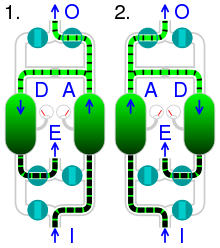
| I | compressed air input | A | adsorption | |
|---|---|---|---|---|
| O | oxygen output | D | desorption | |
| E | exhaust |
Research into and development of the many biochemical and biomedical applications of zeolites, particularly the naturally occurring species heulandite, clinoptilolite and chabazite has been ongoing.[29]
Zeolite-based oxygen concentrator systems are widely used to produce medical-grade oxygen. The zeolite is used as a molecular sieve to create purified oxygen from air using its ability to trap impurities, in a process involving the adsorption of nitrogen, leaving highly purified oxygen and up to 5% argon.
QuikClot brand hemostatic agent, which is used to stop severe bleeding,[30] contains a calcium-loaded form of zeolite found in kaolin clay.[31]
In agriculture, clinoptilolite (a naturally occurring zeolite) is used as a soil treatment. It provides a source of slowly released potassium. If previously loaded with ammonium, the zeolite can serve a similar function in the slow release of nitrogen. Zeolites can also act as water moderators, in which they will absorb up to 55% of their weight in water and slowly release it under the plant's demand. This property can prevent root rot and moderate drought cycles. Clinoptilolite has also been added to chicken food: the absorption of water and ammonia by the zeolite made the birds' droppings drier, less odoriferous and hence easier to handle.[32]
Pet stores market zeolites for use as filter additives in aquaria,[13] where they can be used to adsorb ammonia and other nitrogenous compounds. They must be used with some care, especially with delicate tropical corals that are sensitive to water chemistry and temperature. Due to the high affinity of some zeolites for calcium, they may be less effective in hard water and may deplete calcium. Zeolite filtration is also used in some marine aquaria to keep nutrient concentrations low for the benefit of corals adapted to nutrient-depleted waters.
Where and how the zeolite was formed is an important consideration for aquarium applications. Most Northern hemisphere natural zeolites were formed when molten lava came in contact with sea water, thereby "loading" the zeolite with Na (sodium) sacrificial ions. The mechanism is well known to chemists as ion exchange. These sodium ions can be replaced by other ions in solution, thus the takeup of nitrogen in ammonia, with the release of the sodium. A deposit near Bear River in southern Idaho, (US) is a fresh water variety (Na < 0.05%).[33] Southern hemisphere zeolites are typically formed in freshwater and have a high calcium content.[34]
Zeolite mineral species
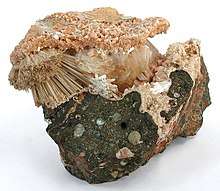
The zeolite structural group (Nickel-Strunz classification) includes:[4][10][35][36][37]
- 09.GA. - Zeolites with T5O10 units (T = combined Si and Al) – the fibrous zeolites
- Natrolite framework (NAT): gonnardite, natrolite, mesolite, paranatrolite, scolecite, tetranatrolite
- Edingtonite framework (EDI): edingtonite, kalborsite
- Thomsonite framework (THO): thomsonite-series
- 09.GB. - Chains of single connected 4-membered rings
- Analcime framework (ANA): analcime, leucite, pollucite, wairakite
- Laumontite (LAU), yugawaralite (YUG), goosecreekite (GOO), montesommaite (MON)
- 09.GC. - Chains of doubly connected 4-membered rings
- Phillipsite framework (PHI): harmotome, phillipsite-series
- Gismondine framework (GIS): amicite, gismondine, garronite, gobbinsite
- Boggsite (BOG), merlinoite (MER), mazzite-series (MAZ), paulingite-series (PAU), perlialite (Linde type L framework, zeolite L, LTL)
- 09.GD. - Chains of 6-membered rings – tabular zeolites
- Chabazite framework (CHA): chabazite-series, herschelite, willhendersonite and SSZ-13
- Faujasite framework (FAU): faujasite-series, Linde type X (zeolite X, X zeolites), Linde type Y (zeolite Y, Y zeolites)
- Mordenite framework (MOR): maricopaite, mordenite
- Offretite–wenkite subgroup 09.GD.25 (Nickel–Strunz, 10 ed): offretite (OFF), wenkite (WEN)
- Bellbergite (TMA-E, Aiello and Barrer; framework type EAB), bikitaite (BIK), erionite-series (ERI), ferrierite (FER), gmelinite (GME), levyne-series (LEV), dachiardite-series (DAC), epistilbite (EPI)
- 09.GE. - Chains of T10O20 tetrahedra (T = combined Si and Al)
- Heulandite framework (HEU): clinoptilolite, heulandite-series
- Stilbite framework (STI): barrerite, stellerite, stilbite-series
- Brewsterite framework (BRE): brewsterite-series
- Others
See also
- Geopolymer, the amorphous alumino-silicate equivalent of zeolite
- List of minerals – A list of minerals for which there are articles on Wikipedia
- Hypothetical zeolite
- Adsorption – Physical phenomenon of adhesion
- Solid sorbents for carbon capture
- Pyrolysis – Thermal decomposition of materials at elevated temperatures in an inert atmosphere
References
- "Zeolite Structure". GRACE.com. W. R. Grace & Co. 2006. Archived from the original on 15 February 2009. Retrieved 8 Feb 2019.
- Cronstedt AF (1756). "Natural zeolite and minerals". Svenska Vetenskaps Akademiens Handlingar Stockholm. 17: 120.
- Breck DW (1973). Zeolite molecular sieves: structure, chemistry, and use. Wiley. ISBN 9780471099857.
- "Database of Zeolite Structures". iza-structure.org. International Zeolite Association. 2017. Retrieved 8 Feb 2019.
- "Minerals Arranged by the New Dana Classification". webmineral.com. Retrieved 8 Feb 2019.
- "News from the Structure Commission". IZA Structure Commission. 2018. Retrieved 8 Feb 2018.
- Marakatti VS, Halgeri AB (2015). "Metal ion-exchanged zeolites as highly active solid acid catalysts for the green synthesis of glycerol carbonate from glycerol". RSC Adv. 5 (19): 14286–14293. doi:10.1039/C4RA16052E. ISSN 2046-2069.
- Marakatti VS, Halgeri AB, Shanbhag GV (2014). "Metal ion-exchanged zeolites as solid acid catalysts for the green synthesis of nopol from Prins reaction". Catal. Sci. Technol. 4 (11): 4065–4074. doi:10.1039/C4CY00596A. ISSN 2044-4761.
- Marakatti VS, Rao PV, Choudary NV, et al. (2014). "Influence of Alkaline Earth Cation Exchanged X-Zeolites Towards Ortho-Selectivity in Alkylation of Aromatics: Hard-Soft-Acid-Base Concept". Advanced Porous Materials. 2 (4): 221–229(9). doi:10.1166/apm.2014.1079.
- Tschernich RW (1992). Zeolites of the World. Geoscience Press. ISBN 9780945005070.
- Rollmann LD, Valyocsik EW, Shannon RD (1995). "Zeolite Molecular Sieves". In Murphy DW, Interrante LV (eds.). Inorganic Syntheses: Nonmolecular Solids. Inorganic Syntheses. 30. New York: Wiley & Sons. pp. 227–234. doi:10.1002/9780470132616.ch43. ISBN 9780470132616.
- "Zeolites (natural)" (PDF). USGS Mineral Commodity Summaries. 2011. Retrieved 8 Feb 2019.
- Virta RL (2011). "2009 Minerals Yearbook - Zeolites" (PDF). USGS. Retrieved 8 Feb 2019.
- Earl DJ, Deem MW (2006). "Toward a Database of Hypothetical Zeolite Structures". Ind. Eng. Chem. Res. 45 (16): 5449–5454. doi:10.1021/ie0510728. ISSN 0888-5885.
- Szostak R (1998). Molecular Sieves - Principles of Synthesis and Identification. Van Nostrand Reinhold Electrical/Computer Science and Engineering Series. Springer. ISBN 9780751404807.
- Roth WJ, Nachtigall P, Morris RE, et al. (2013). "A family of zeolites with controlled pore size prepared using a top-down method". Nat. Chem. 5 (7): 628–633. doi:10.1038/nchem.1662. hdl:10023/4529. ISSN 1755-4330. PMID 23787755.
- Bhatia S (1989). Zeolite Catalysts: Principles and Applications. Boca Raton: CRC Press. ISBN 9780849356285.
- Nelson B (2018). "Add another strange property to the list of silver's bizarre traits". MNN. Narrative Content Group. Retrieved 9 Feb 2019.
- "On-Board Oxygen Generating System (OBOGS)". Honeywell.com. Honeywell International Inc. Archived from the original on 10 September 2011. Retrieved 9 Feb 2019.
- The Associated Press (16 Apr 2011). "Level of Radioactive Materials Rises Near Japan Plant". NYTimes. ISSN 0362-4331.
- "Compact and flexible thermal storage". Fraunhofer Research News. Fraunhofer-Gesellschaft. 1 Jun 2012.
- U.S. Pat. No. 4,269,170, "Adsorption Solar Heating and Storage System," Filed April 27, 1978, Inventor: John M. Guerra
- U.S. Patent No. 4,034,569, Filed Nov. 4, 1974, Inventor: Dimiter I. Tchernev
- Ventura G, Risegari L (2007). The Art of Cryogenics: Low-Temperature Experimental Techniques. Elsevier. p. 17. ISBN 9780080444796.
- Dypayan J (2007). "Clinoptilolite – a promising pozzolan in concrete" (PDF). A New Look at an Old Pozzolan. 29th ICMA Conference. Quebec City, Canada: Construction Materials Consultants, Inc. pp. 168–206. Retrieved 7 Oct 2013.
- Andrejkovičová S, Ferraz E, Velosa AL, et al. (2012). "Air Lime Mortars with Incorporation of Sepiolite and Synthetic Zeolite Pellets" (PDF). Acta Geodynamica et Geomaterialia. 9 (1): 79–91.
- Ferraza E, Andrejkovičová S, Velosa AL, et al. (2014). "Synthetic zeolite pellets incorporated to air lime–metakaolin mortars: mechanical properties". Construction & Building Materials. 69: 243–252. doi:10.1016/j.conbuildmat.2014.07.030.
- Dietrich RV (2005). "Thomsonite". GemRocks. Retrieved 2 Oct 2013.
- Auerbach SM, Carrado KA, Dutta PK, eds. (2003). Handbook of Zeolite Science and Technology. Boca Raton: CRC Press. p. 16. ISBN 9780824740207.
- Rhee P, Brown C, Martin M, et al. (2008). "QuikClot use in trauma for hemorrhage control: case series of 103 documented uses". J. Trauma. 64 (4): 1093–9. doi:10.1097/TA.0b013e31812f6dbc. PMID 18404080.
- Rowe A (2018). "Nanoparticles Help Gauze Stop Gushing Wounds". Wired. Condé Nast. Retrieved 1 Nov 2013.
- Mumpton FA (1985). "Ch. VIII. Using Zeolites in Agriculture" (PDF). In Elfring C (ed.). Innovative Biological Technologies for Lesser Developed Countries. Washington, DC: US Congress, Office of Technology Assessment. LCCN 85600550.
- Hongting Z, Vance GF, Ganjegunte GK, et al. (2008). "Use of zeolites for treating natural gas co-produced waters in Wyoming, USA". Desalination. 228 (1–3): 263–276. doi:10.1016/j.desal.2007.08.014.
- Wang, Shaobin; Peng, Yuelian (2009-10-09). "Natural zeolites as effective adsorbents in water & wastewater treatment" (PDF). Chemical Engineering Journal. 156 (1): 11–24. doi:10.1016/j.cej.2009.10.029. Retrieved 2019-07-13.
- "Database of Mineral Properties". IMA. Retrieved 9 Feb 2019.
- "Nickel-Strunz Classification - Primary Groups 10th ed". mindat.org. Retrieved 10 Feb 2019.
- First EL, Gounaris CE, Wei J, et al. (2011). "Computational characterization of zeolite porous networks: An automated approach". Phys. Chem. Chem. Phys. 13 (38): 17339–17358. doi:10.1039/C1CP21731C. PMID 21881655.

Further reading
- Sheppard RA (1973). "Zeolites in Sedimentary Rocks". In Brobst DA, Pratt WP (eds.). United States mineral resources. Professional Paper. 820. Washington, DC: USGS. pp. 689–695. doi:10.3133/pp820.
- Clifton RA (1987). Natural and Synthetic Zeolites. Information Circular, 9140. Pittsburgh: USBM. OCLC 14932428.
- Mumpton FA (1999). "La roca magica: Uses of natural zeolites in agriculture and industry". PNAS. 96 (7): 3463–3470. Bibcode:1999PNAS...96.3463M. doi:10.1073/pnas.96.7.3463. PMC 34179. PMID 10097058.
- Monnier JB, Dupont M (1983). "Zeolite-water close cycle solar refrigeration; numerical optimisation and field-testing". Proc. Annu. Meet. - Am. Sect. Int. Sol. Energy Soc. 6: 181–185. OSTI 5126636. American Solar Energy Society meeting. 1 Jun 1983. Minneapolis, MN, USA
- Newsam JM (1992). "Zeolites". In Cheetham AK, Day P (eds.). Solid State Chemistry. 2. Clarendon Press. ISBN 9780198551669.
- Rhodes CJ (2007). "Zeolites: Physical Aspects and Environmental Applications". Annu. Rep. Prog. Chem. C. 103: 287–325. doi:10.1039/b605702k.
External links
| Wikimedia Commons has media related to Zeolite. |